The brochure for the new fifth-generation Mercedes-Benz C-Class would, in places, be better promotional material for oversized sunglasses and expensive sandals than it is for a car.
You will know the score: it’s full of pouting young models in designer clothes arranged around a car in which they have an apparently disdainful level of disinterest. In this case, one of them is actually sitting on the roof of a grey C-Class Estate wearing a black trench coat, black leather boots and Grace Jones-style ‘eyewear’. As ironic as this might sound in light of our current throwback fashion trends, I’m pretty confident that nobody who dressed anything like that ever advertised the 190E in 1982.
The young lady in question is picnicking with what appears to be the shiniest cocktail shaker in the known universe and clutching a massive pretzel almost as if it were a steering wheel. And she just happens to have chosen to do all that on the roof of her C-Class. Frankly, it’s beyond my powers of parody.
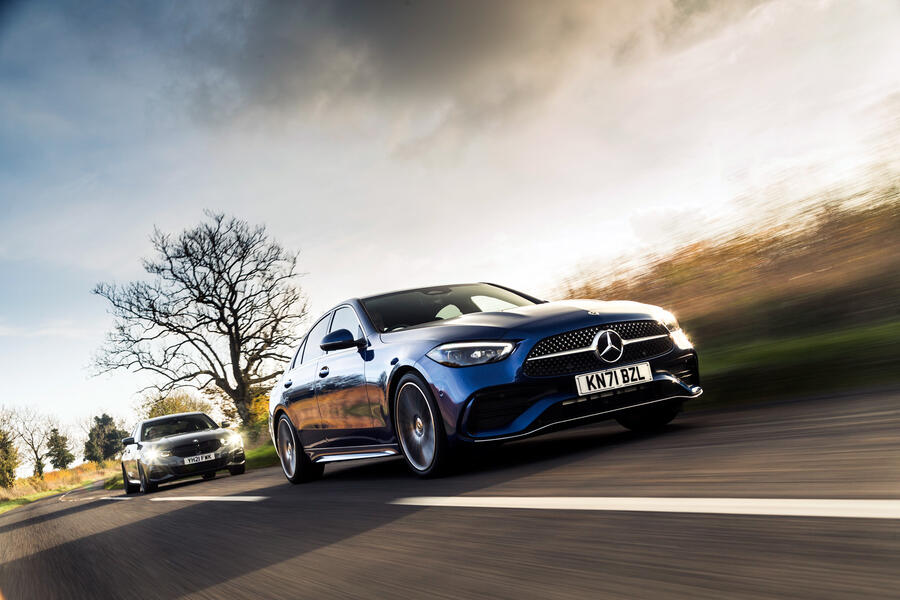
Much as she might look a bit like a person to whom Mercedes would want to sell a C-Class, however, this person isn’t anything like the one who will actually buy one. Mercedes wants to use technology, fully networked connectivity and very daft brochure photography to bring younger customers into the fold. I get it. Honestly, though, it seems to me that they’re burying the lead. The most valuable and marketable commodity that this car has right now, which twenty-something models in expensive-looking accessories do absolutely nothing to speak to, must surely be reassurance.
In these times in which we find ourselves, fully electric family cars of comparable prices not only exist but are being made more financially appealing, both to buy and to run, than their piston-engined counterparts. And when those EV alternatives are almost universally saluted by governments and the various courts of public opinion alike as the virtuous future of personal transport, surely the people who will buy this car – a conventional, albeit mildly hybridised, piston-engined compact executive saloon from the car maker with the longest ‘legacy’ in the business – will do so simply because they know it will work.
Whatever their daily life might throw at them or wherever it might lead, they know that a familiar, combustion-powered C-Class will cope. They know it will soak up the challenges, strains and stresses of the everyday, soothe away the miles and surround them all in a comforting, luxury techno-glow while doing it. Mercedes is just that kind of brand.
So how far might that sense of reassurance, allied to a revised platform, a new look and a cabin packed with Mercedes-Benz S-Class-inspired infotainment technology, take the new C-Class when judged alongside its keenest competitors? That’s our departure point for today, and to help provide some answers is a car you might expect and one you might not.

Directly opposite Stuttgart’s new 197bhp, four-cylinder diesel-powered C220d AMG Line Premium is our compact executive class leader, the BMW 320d M Sport. But there’s also a Jaguar XF D200 R-Dynamic S – a British-built executive option which, given that it technically belongs in the class above the Mercedes and BMW, you might expect to cost more than either. However, at showroom list price at least, it now actually costs less.
A workaday diesel-engined 3 Series has long been more than a match for an equivalent C-Class for driver appeal, but is it still? Even if it is, might the new Mercedes be able to claw back a result for its brand-typical qualities of refinement, comfort, drivability and luxury appeal? Or will the German saloons be shaded by the updated XF, which brings levels of accommodation and sophistication from the class above and aims to combine them with Jaguar’s trademark supple, surface-sensitive ride and handling allure?
Let’s put down the pretzel, holster the shiny cocktail shaker and find out.
There’s something a little bland about the way Mercedes’ design is currently going. But given the ignominious criticism that has wedgy boldness and visual cut and thrust to make them stand out. This one looks, to these eyes at least, like another slightly amorphous copy.
Take the 320d by way of contrast. Granted, if you have one in M Sport Pro Pack specification, like our car, it will come with that awful black kidney grille, which looks like it has been tacked on (or maybe just shaded in with the paint bucket tool in Photoshop). I would certainly be keen to find out from my dealer how much of the contents of the Pro Pack could be ordered independently of that ‘extended shadowline’ grille. That apart, though, it manages to look like both a BMW and a 3 Series, and that, it seems to me, is the trick that the C-Class is missing.
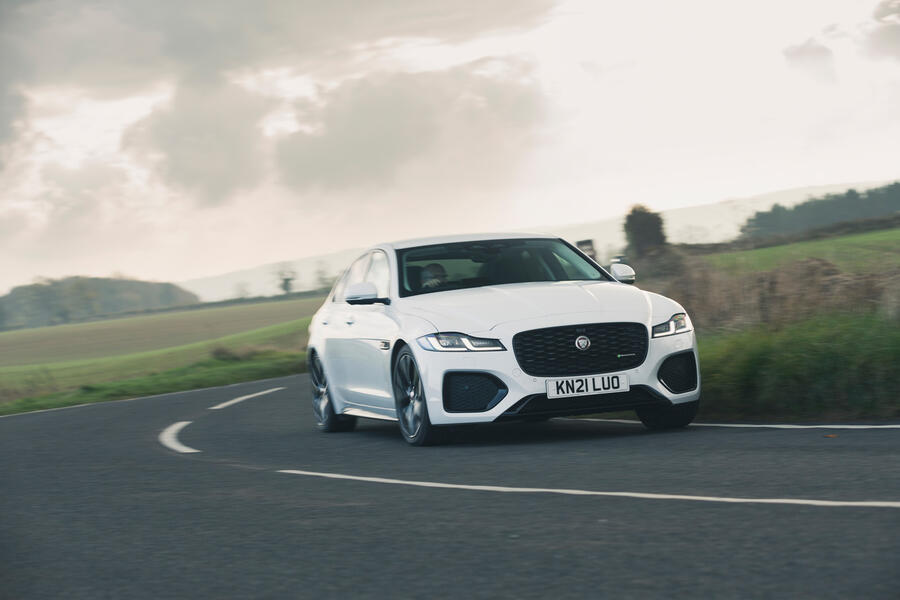
The Jaguar, meanwhile, wears its black body trim much more discreetly than the BMW, and it remains as handsome and distinctive a car today as it was when introduced in 2015. The car’s sales fortunes in the six years since have plainly demonstrated how much more it takes than great exterior design and tidy ride and handling to sell saloon cars, though. But as of earlier this year, the XF has offered so much more. It has offered much-boosted, premium-worthy interior cabin quality and material lustre; it has offered a really impressive Pivi Pro touchscreen infotainment system and digital instruments for upper trim levels; and it has offered the same levels of practicality, which didn’t make it recommendable next to the E-Class but certainly make it seem roomy alongside the C-Class.
And it has offered value. Our particular test cars muddied a perfect comparison a little bit, because we could only source a four-wheel-drive XF D200 for this test. But if you compare like with like across these three cars, a cash buyer might be looking at a rear-driven XF R-Dynamic SE for less than £37,000, versus a 320d M Sport at more than £40,000 or a C220d AMG Line at more than £42,000. Pretty remarkable, that: the biggest car here comes with the littlest price tag.
ttlest price tag. On monthly finance, however, the Jaguar isn’t quite so remarkable. The BMW’s better forecast residual values and better manufacturer finance support would make it cheaper than the Jaguar on a typical three-year PCP deal, albeit only by about £50 per month. The Mercedes would be cheaper than the Jaguar too, if by a smaller margin. Still, the XF is definitely in the same conversation now. Its new lease of life might materialise just yet.
Onto interiors, then. If what you want from your executive saloon is an expensive-feeling, richly equipped cockpit with room for adults in both rows, all three cars deliver. It’s here, of course, that the Mercedes’ S-Class hand-me-downs ought to give it an early lead, but surprisingly to some, perhaps, they don’t.
Sure, there’s that 11.9in, Tesla-tribute central infotainment display screen, with its upgraded ‘natural speech’ voice recognition system, its integrated three-platform music streaming and its over-the-air software update networked connectivity. But, now without a separate tactile input device and relying on touchscreen inputs alone to operate it, the system isn’t the most intuitive of its kind. It requires multiple swipes and prods to achieve a given result which other systems deliver more simply. Being angled the way it is, it can also reflect light into your eyes through the passenger-side window in a way that a less steeply raked screen wouldn’t. Honestly, I prefer the systems in both the BMW and the Jaguar.
For practicality, fewer surprises are in store. The Jaguar has the biggest back seats and a boot that’s bigger than those of its rivals by about 10% (but then the car is more than six inches longer than the C-Class overall). But it’s the 3 Series that feels the best-packaged car of the three. As a 6ft 3in adult sitting in the back of the BMW, you’re nearly as comfortable as you might be in the XF. Move to the Mercedes and, even though Stuttgart claims to have added both knee and elbow room, you will soon find the roof lining with the top of your head and the front seat backs with your knees.
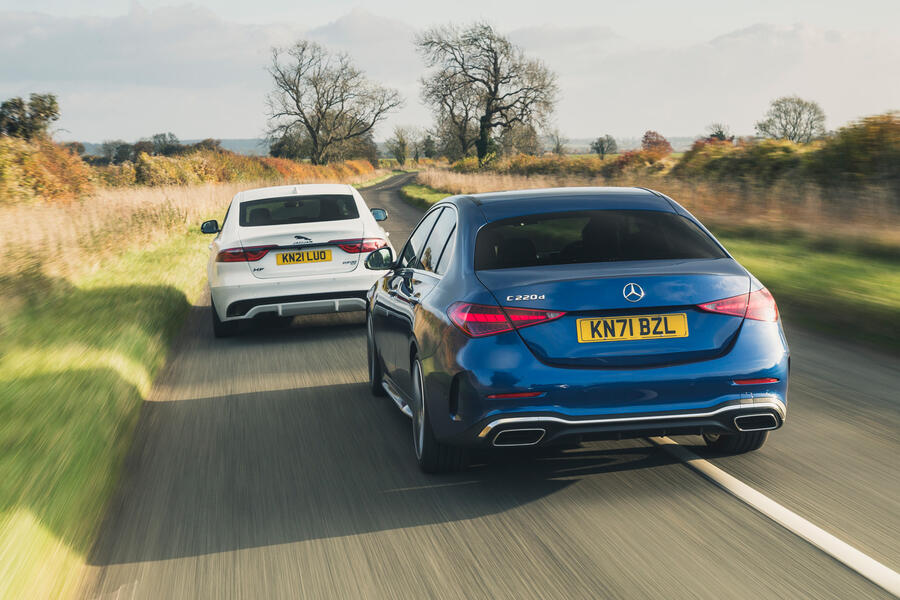
Up front, there are also hints of restriction around your toes in the C-Class’s footwell. The driver’s seat is not only more perched than in the 3 Series but also less enveloping and, while softer, less comfortable. But it’s the Mercedes’ decidedly mixed material quality and finish that disappoints further still. The C-Class’s ambience has a familiar glitzy, ambient-lighting-heavy, gloss-and-chrome theme.
At its uppermost level, the dashboard’s fittings feel as good as they look; but there are sharp edges and quite nasty, shiny, wobbly moulded plastics around the car’s steering column, along with some loose fittings in the footwell. By comparison, the BMW’s interior quality is less superficially ritzy but markedly more consistent, and the Jaguar’s is at least as good. That’s a slip-up by Stuttgart’s high standards – and it might prove a telling one.
Four-cylinder diesel engines might seem like a strange place to start in a test of executive cars at the end of 2021, but the C220d remained the biggest-selling C-Class of the lot right until the removal of the previous W205-generation model. There will be petrol and diesel-electric plug-in hybrid versions of this car along in good time, both with impressive-sounding 60-odd-mile claimed electric-only ranges. But what of the meat-and-potatoes version?
Well, it’s torquey all right. It’s also a little bit coarser and more gravelly sounding under load than either the 320d or the XF D200, although it proves to be more refined at cruising revs. The order of merit for comfort, refinement and isolation in this test is led clearly by the Jaguar, and has the C220d in nip-and-tuck contention with the 320d for runner-up credit. Would a C-Class customer expect better? I reckon they probably would – and should.
In the real world, outright performance probably wins these cars less credit than drivability, and the C-Class does better on that score. None of them has much of a sporting turn of pace, because mid-range four-pot diesel engines in cars of this size have never really offered such a thing. But all three cars hit that familiar-feeling, everyday-use sweet spot. All three are gutsy and highly flexible up to motorway speeds and ready at least to knock on the door of 50mpg on a longer cruise. The XF would get close to that economy; both the BMW and the Mercedes would narrowly surpass it.
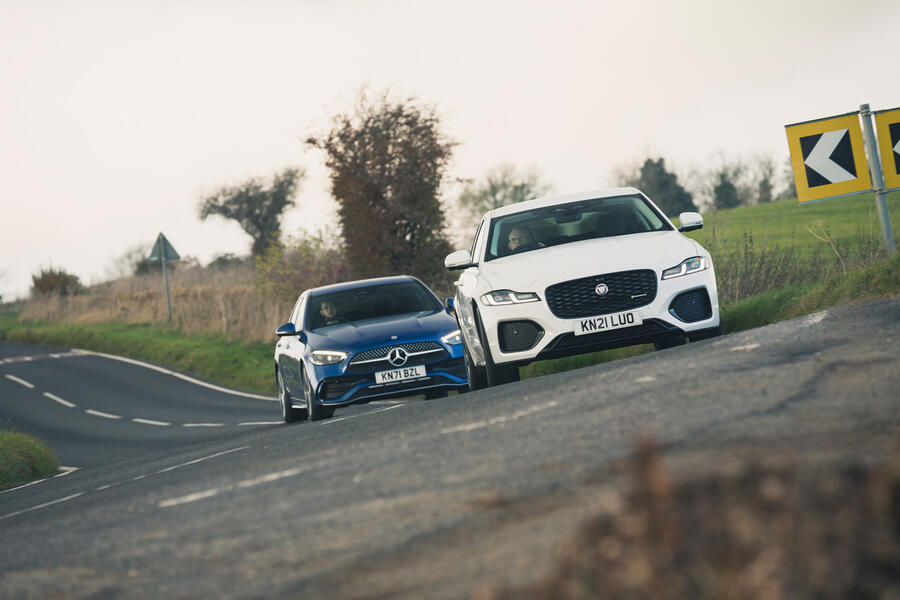
Where the Jaguar’s torque feels a little bit smothered by its kerb weight, the Mercedes feels stronger on the move and the engine ready to pull harder from lower revs. The BMW’s diesel has a more balanced character, though, and is a less harsh audible presence. Its outputs might look a bit meagre on paper, but the engine pulls more consistently throughout the rev range and spins more willingly above 4000rpm than either the Mercedes or the Jaguar can manage.
The BMW’s weight is in play here, too, just as it is in the way it rides and handles. Mass is clearly the friend and co-conspirator of the 320d, which rides a little firmly and with just the merest hint of skittishness over ruts and bumps taken at speed on account of its (optional) run-flat tyres. But its balance of grip, body control and handling precision are all first-rate. There’s an easy flatness and instant poise to cornering in the 320d, or you can dial the adaptive dampers back into their Comfort mode and still know that you’re driving something that’s a little bit taut, lithe and special.
The C220d seats you higher than does the 320d, but it also clearly rolls a shade further before it bites in towards an apex. Its ride can filter and absorb a little more topographical interference from the road than the BMW’s can, but it also becomes more disturbed by bigger suspension inputs at higher speeds than the 320d. It’s noisier over sharp edges around town, too, while its handling isn’t as keenly, cleanly balanced as the BMW’s and it isn’t nearly as engaging to drive.
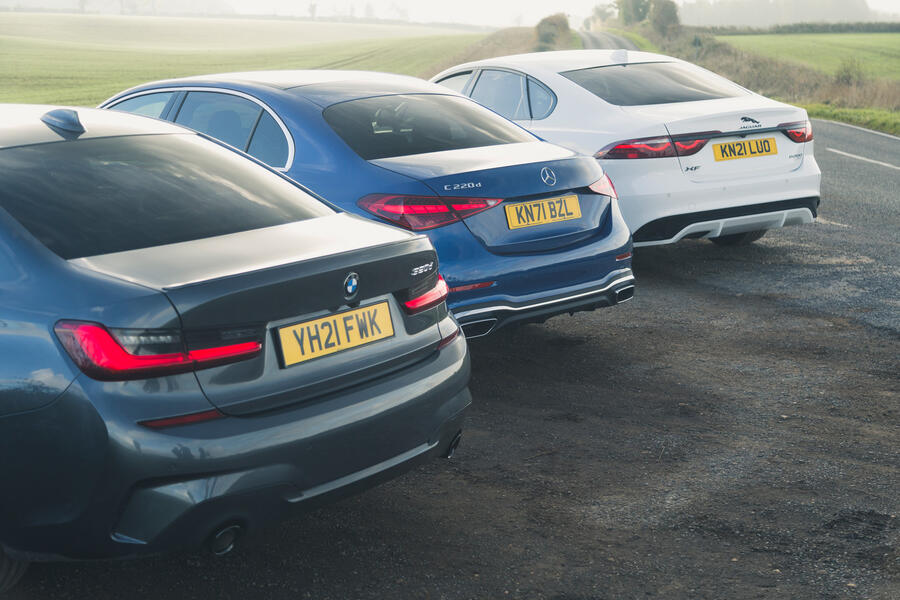
The XF’s chassis has a natural affinity for UK country roads that exceeds even that of the 3 Series. Pick just the right cruising pace and it will float and glide along so beautifully and quietly that you would never grow tired of it. Steering sweetly and communicating just enough all the while, it will do that without the advantage of adaptive dampers and even on optional 19in wheels (as our test car proved), in a way that Mercedes’ chassis engineers would benefit from studying before they set about refining the much more vocal, sometimes clunkier ride of the C-Class. A saloon-appropriate ride and handling compromise has rarely felt so finely honed.
But while it’s beguiling at just so pace, the XF doesn’t have the handling poise, the body control or the dynamic range of the 320d. That came as a surprise: I thought the Jaguar might just ambush our compact executive class champion from its hide in the long grass in this test, but it can’t. It’s too big and too heavy – too old, perhaps, deep down under the skin.
The new C-Class, on the other hand, was always unlikely to beat either of these cars for driver appeal, even though it does have youth on its side. But it’s more telling to us that Mercedes’ long-established strong suits aren’t better represented in this latest-generation version. Simply put, this car ought to be better. Quieter, more practical, better built, slicker and easier to operate and to drive. Perhaps other versions will do better on some of those scores, but this certainly isn’t the best first impression.
Are clever LED headlights, built-in music streaming services and over-the-air software updates really what Mercedes thinks we want from our luxury cars, I wonder. Because from where I’m sitting, the assured aura of tank-like comfort and quality-first, old-school Benz would have been a much better fit for the mood of these uncertain times.

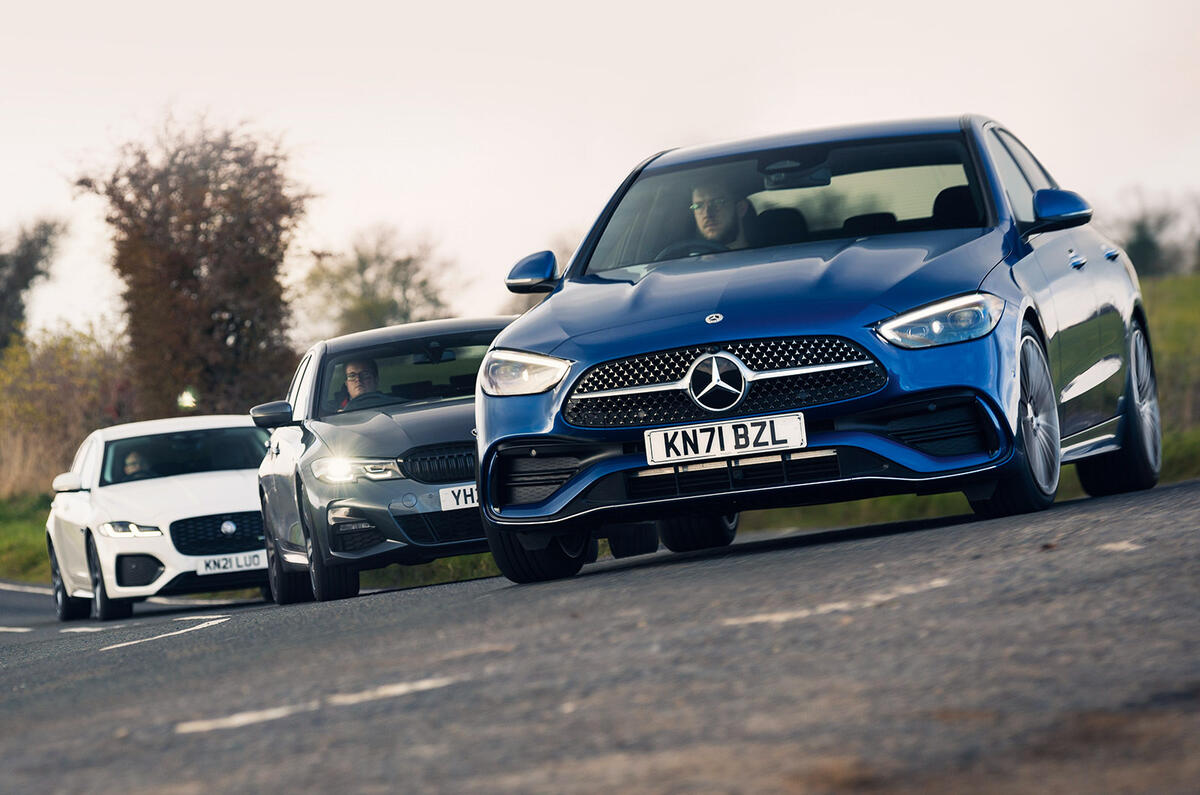
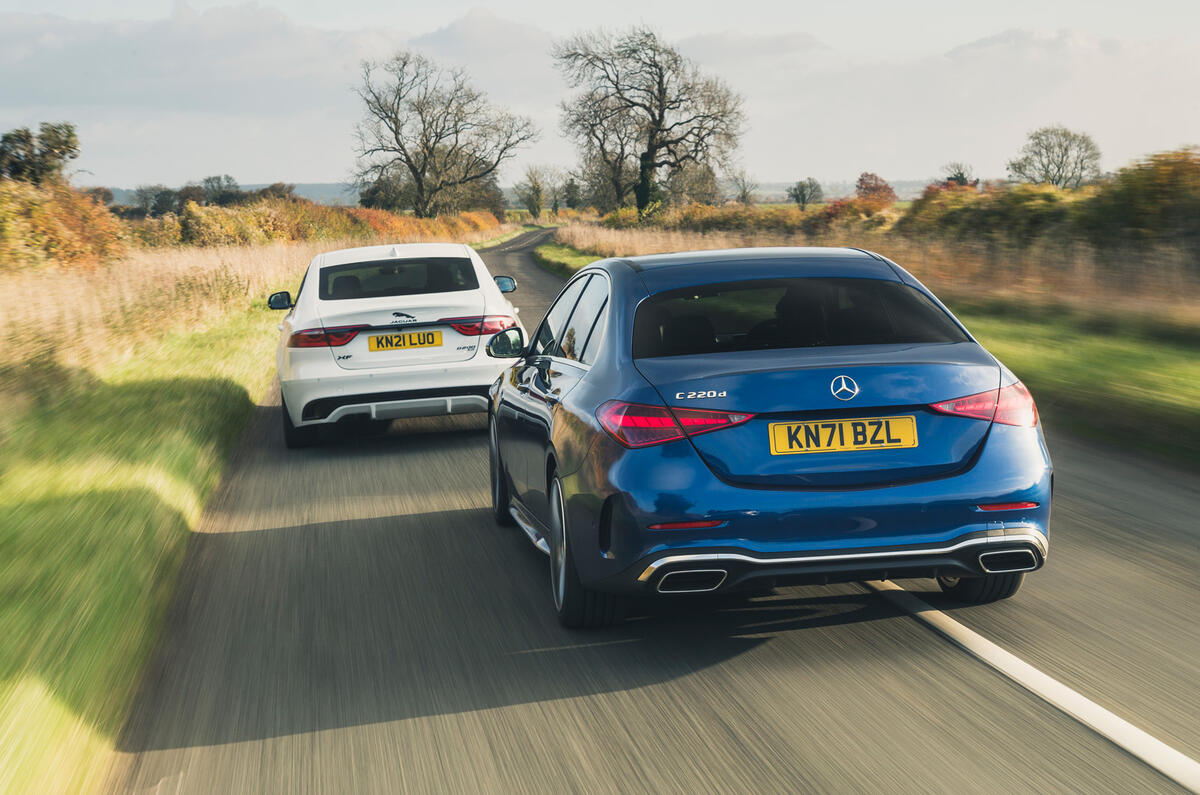
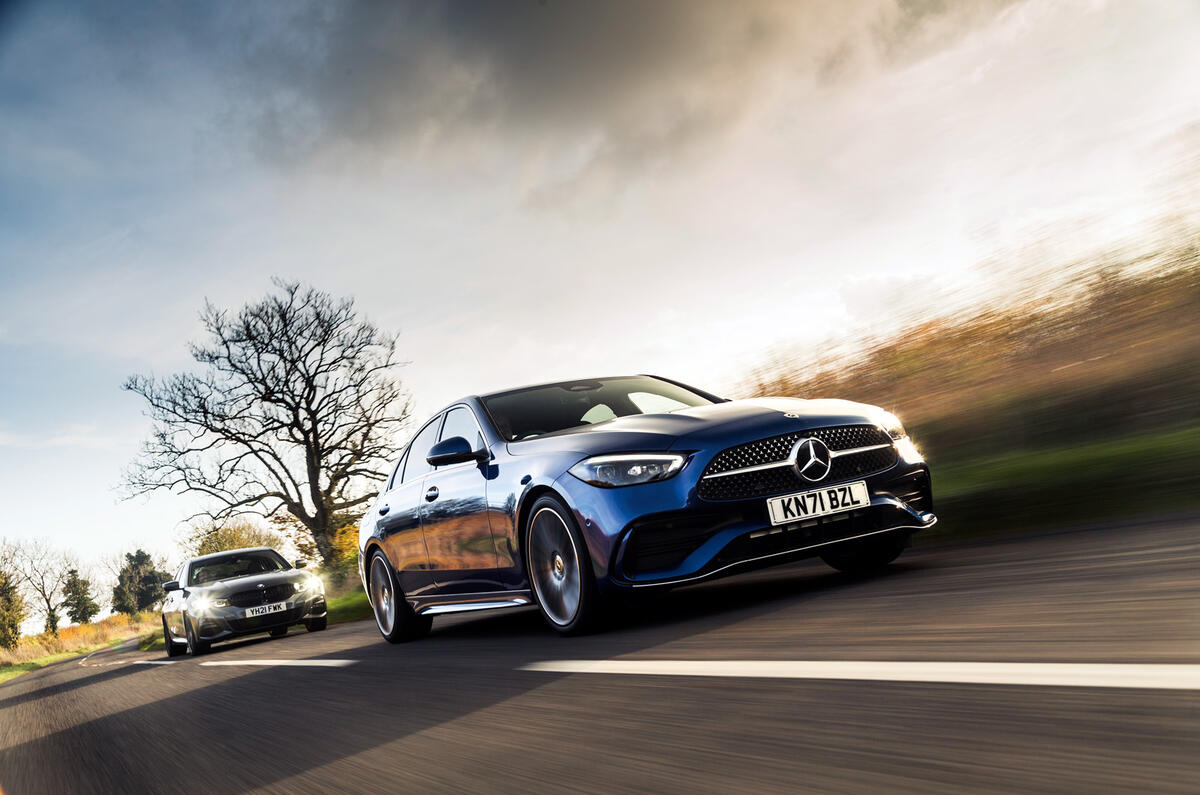
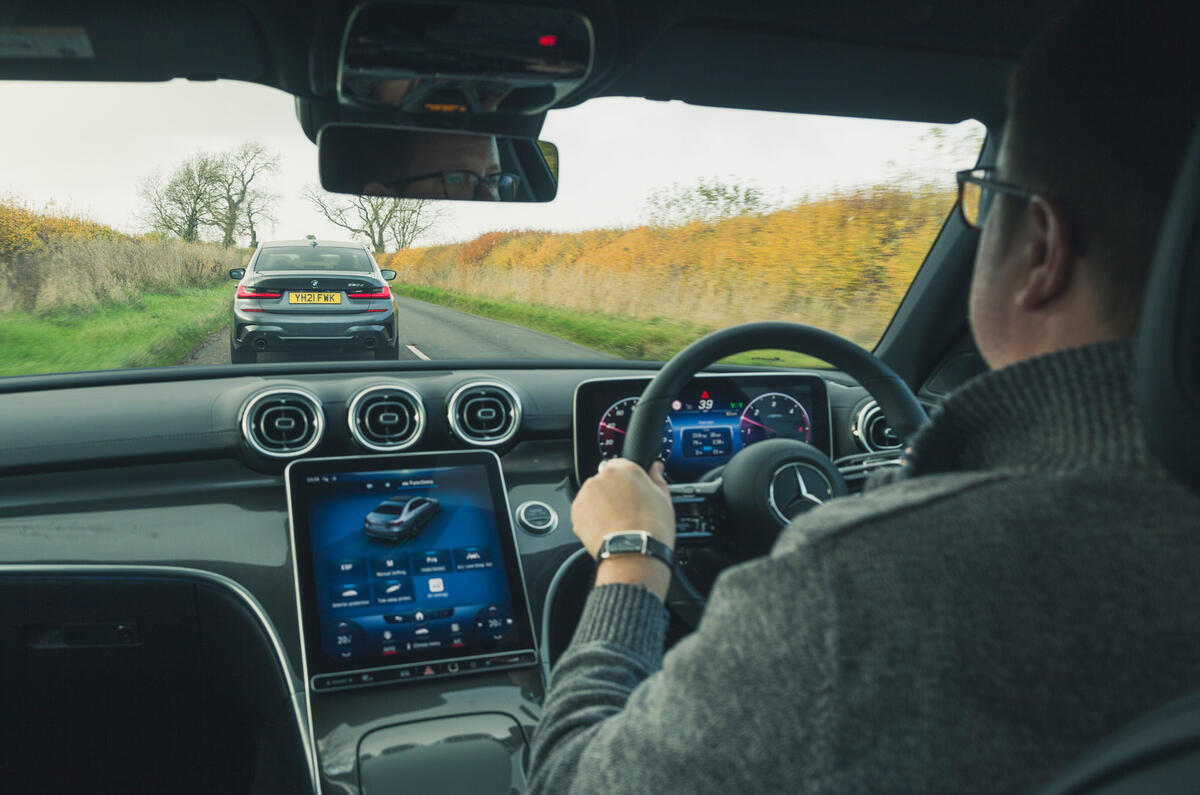
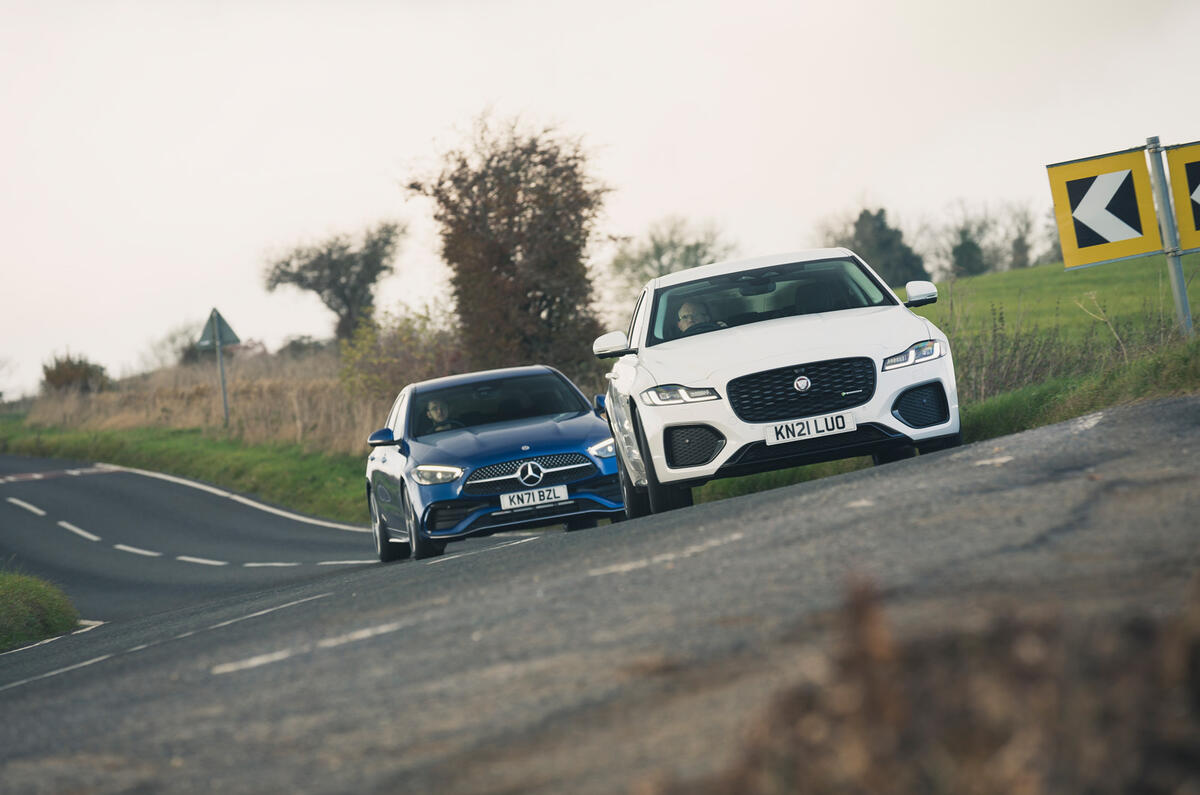
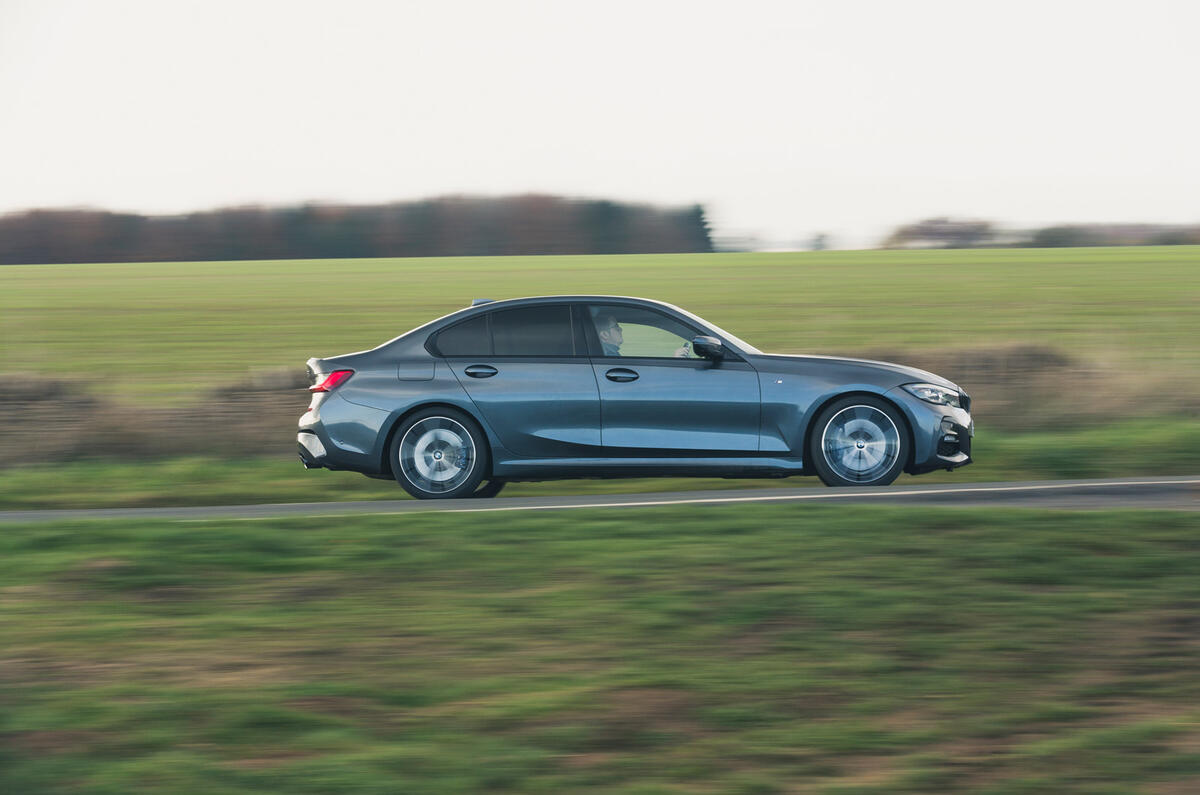

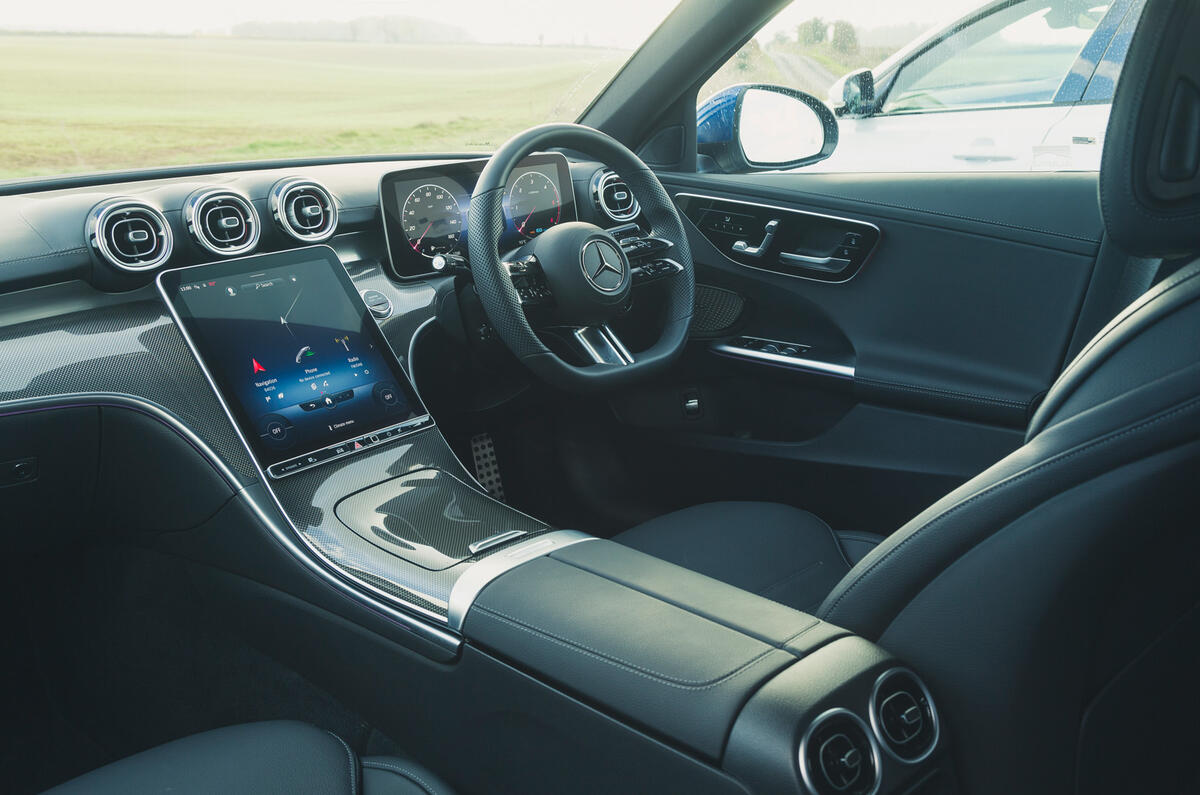
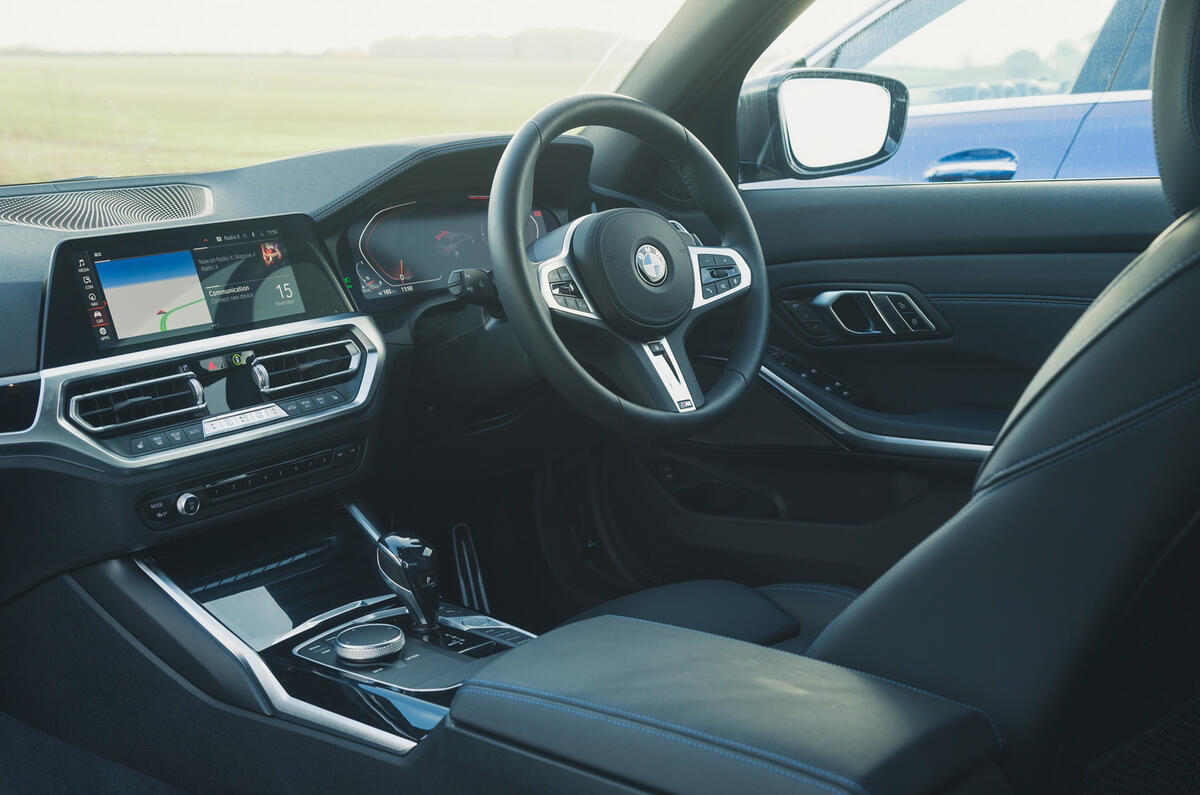



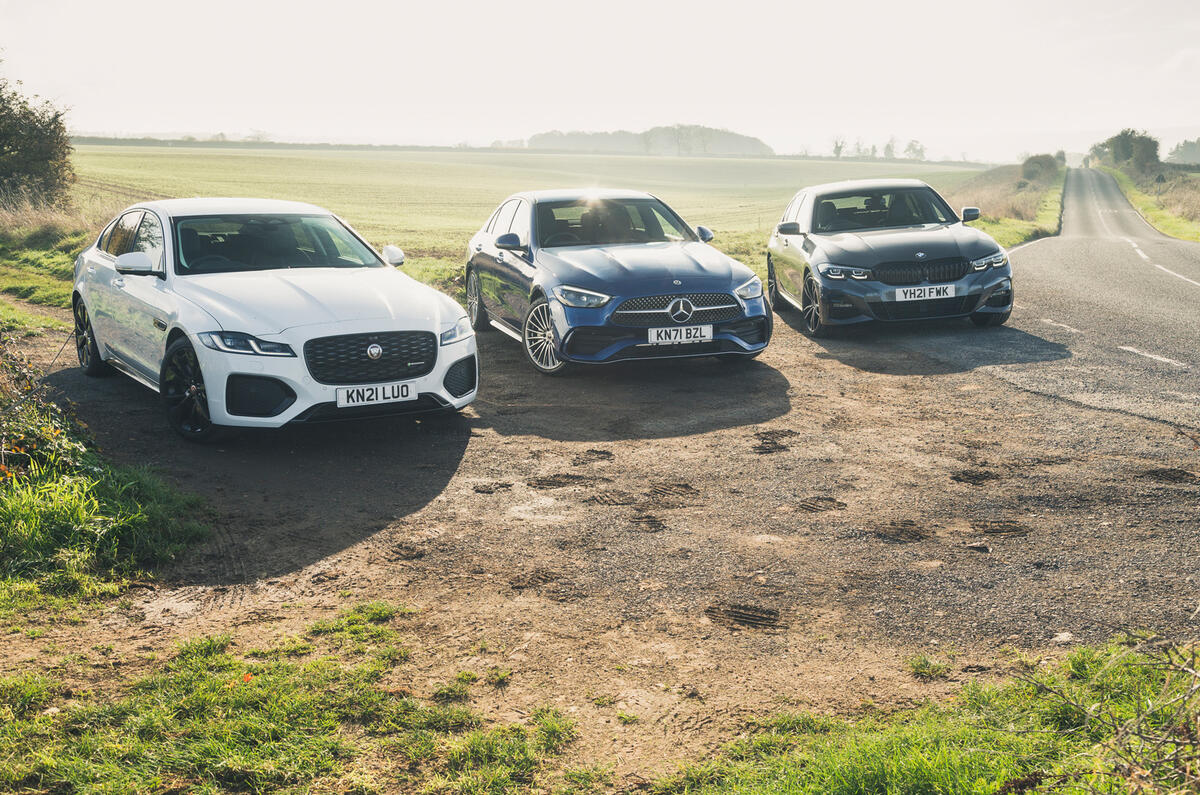


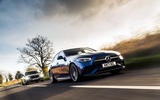


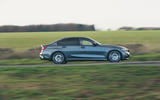
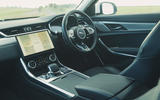
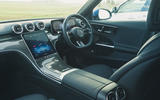
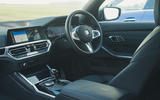
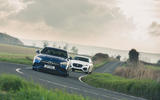
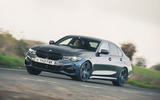
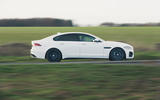







Join the debate
Add your comment
Why are they testing and XF against a 3 series and a C class and then saying its too big and too heavy? The XF isnt a 3 series or a C Class rival, the smaller, lighter XE is, more shoddy journalism. However the XE would still have come last because its not very good.
"Are clever LED headlights, built-in music streaming services and over-the-air software updates really what Mercedes thinks we want from our luxury cars.."
I think thats exactly what a lot of current Mercedes customers want. This appears to be another average, blinged up interior Merc, and why does it have to weigh so much more than the BMW?
The class above has always been much more refined cars. Hard to explain why but whether BMW Jag or Merc the bigger cars in my experience were always better by more than you would expect mostly ride and refinement. The down size is they were 5m long but now that's not much different to the latest 3 series. The Jag deserves to sell but newer glitzy Merc and all round BM will still sell more suppose cheap lease helps. No justice in the world.